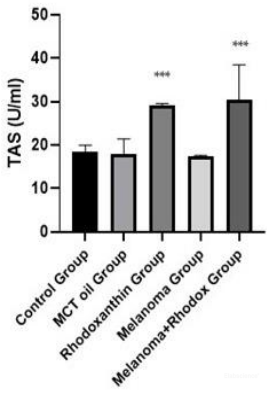Total Antioxidant Capacity (T-AOC) Colorimetric Assay Kit
SKU: E-BC-K136-M-500
Total Antioxidant Capacity (T-AOC) Colorimetric Assay Kit
| SKU # | E-BC-K136-M |
| Detection Instrument | Microplate reader (500-520 nm, optimum wavelength: 520 nm) |
| Detection method | Colorimetric method |
Product Details
Properties
| Synonyms | T-AOC |
| Sample Type | Serum, plasma, whole blood, tissue, cells, cell culture supernatant |
| Sensitivity | 0.62 U/mL |
| Detection Range | 0.62-190.43 U/mL |
| Detection Method | Colorimetric method |
| Assay type | Enzyme Activity |
| Assay time | 50 min |
| Precision | Average inter-assay CV: 5.600% | Average intra-assay CV: 4.800% |
| Other instruments required | Micropipettor, Centrifuge, Incubator, Vortex mixer |
| Other reagents required |
Normal saline (0.9% NaCl), PBS (0.01 M, pH 7.4) |
| Storage | 2-8℃ |
| Valid period | 12 months |
Images
D-A Dumitras et al investigate the antioxidant capacity of rhodoxanthin that can inhibit tumor growth. Total antioxidant capacity (T-AOC) in mouse plasma was determined using T-AOC colorimetric assay kit (E-BC-K136-M).

The capacity of antioxidant was significantly increased by rhodoxanthin treatment. (***P<0.001)
Dilution of Sample
It is recommended to take 2~3 samples with expected large difference to do pre-experiment before formal experiment and dilute the sample according to the result of the pre-experiment and the detection range (0.62-190.43 U/mL).
The recommended dilution factor for different samples is as follows (for reference only):
| Sample type | Dilution factor |
| Human serum | 1 |
| Human urine | 1-2 |
| 10% Rat liver tissue homogenate | 1 |
| 10% Epipremnum aureum tissue homogenate | 1 |
| HepG2 cells | 1 |
| HepG2 cell culture supernatant | 1 |
Note: The diluent is normal saline (0.9% NaCl) or PBS (0.01 M, pH 7.4).
Detection Principle
A variety of antioxidant macromolecules, antioxidant molecules and enzymes in a system can eliminate all kinds of reactive oxygen species and prevent oxidative stress induced by reactive oxygen species. The total level reflect the total antioxidant capacity in the system. Many antioxidants in the body can reduce Fe3+ to Fe2+ and Fe2+ can form stable complexes with phenanthroline substance. The antioxidant capacity (T-AOC) can be calculated by measuring the absorbance at 520 nm.
Kit Components & Storage
| Item | Component | Size 1(48 T) | Size 2(96 T) | Storage |
| Reagent 1 | Buffer Solution | 6 mL × 1 vial | 12 mL × 1 vial | 2-8°C, 12 months |
| Reagent 2 | Chromogenic Agent | Powder ×1 vial | Powder × 2 vials | 2-8°C, 12 months, shading light |
| Reagent 3 | Ferric Salt Stock Solution | 0.2 mL × 1 vial | 0.4 mL × 1 vial | 2-8°C, 12 months, shading light |
| Reagent 4 | Ferric Salt Diluent | 4 mL × 1 vial | 8 mL × 1 vial | 2-8°C, 12 months |
| Reagent 5 | Stop Solution | 1.25 mL × 1 vial | 1.25 mL × 2 vials | 2-8°C, 12 months |
| Reagent 6 | Clarificant | 1.25 mL × 1 vial | 1.25 mL × 2 vials | 2-8°C, 12 months |
| Microplate | 96 wells | No requirement | ||
| Plate Sealer | 2 pieces | |||
Note: The reagents must be stored strictly according to the preservation conditions in the above table. The reagents in different kits cannot be mixed with each other. For a small volume of reagents, please centrifuge before use, so as not to obtain sufficient amount of reagents.
Technical Data:
Parameter:
Intra-assay Precision
Three human serum samples were assayed in replicates of 20 to determine precision within an assay. (CV = Coefficient of Variation)
| Parameters | Sample 1 | Sample 2 | Sample 3 |
| Mean (U/mL) | 3.50 | 64.50 | 138.50 |
| %CV | 5.1 | 4.7 | 4.6 |
Inter-assay Precision
Three human serum samples were assayed 20 times in duplicate by three operators to determine precision between assays.
| Parameters | Sample 1 | Sample 2 | Sample 3 |
| Mean (U/mL) | 3.50 | 64.50 | 138.50 |
| %CV | 5.3 | 5.7 | 5.8 |
Recovery
Take three samples of high concentration, middle concentration and low concentration to test the samples of each concentration for 6 times parallelly to get the average recovery rate of 96%.
| Standard 1 | Standard 2 | Standard 3 | |
| Expected Conc. (U/L) | 22.5 | 84.6 | 164.5 |
| Observed Conc. (U/L) | 22.3 | 80.4 | 154.6 |
| Recovery rate (%) | 99 | 95 | 94 |
Sensitivity
The analytical sensitivity of the assay is 0.62 U/mL. This was determined by adding two standard deviations to the mean O.D. obtained when the zero standard was assayed 20 times, and calculating the corresponding concentration.



